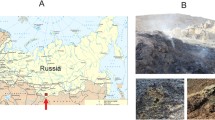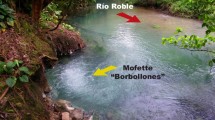Abstract
Some novel actinobacteria from geothermal environments were shown to grow autotrophically with sulfur as an energy source. These bacteria have not been formally named and are referred to here as “Acidithiomicrobium” species, as the first of the acidophilic actinobacteria observed to grow on sulfur. They are related to Acidimicrobium ferrooxidans with which they share a capacity for ferrous iron oxidation. Ribulose bisphosphate carboxylase/oxygenase (RuBisCO) is active in CO2 fixation by Acidimicrobium ferrooxidans, which appears to have acquired its RuBisCO-encoding genes from the proteobacterium Acidithiobacillus ferrooxidans or its ancestor. This lateral transfer of RuBisCO genes between a proteobacterium and an actinobacterium would add to those noted previously among proteobacteria, between proteobacteria and cyanobacteria and between proteobacteria and plastids. “Acidithiomicrobium” has RuBisCO-encoding genes which are most closely related to those of Acidimicrobium ferrooxidans and Acidithiobacillus ferrooxidans, and has additional RuBisCO genes of a different lineage. 16S rRNA gene sequences from “Acidithiomicrobium” species dominated clone banks of the genes extracted from mixed cultures of moderate thermophiles growing on copper sulfide and polymetallic sulfide ores in ore leaching columns.



Similar content being viewed by others
References
Badger MR, Bek EJ (2008) Multiple Rubisco forms in proteobacteria: their functional significance in relation to CO2 acquisition by the CBB cycle. J Exp Bot 59:1525–1541
Baker BJ, Banfield JF (2003) Microbial communities in acid mine drainage. FEMS Microbial Ecol 44:139–152
Burton NP, Norris PR (2000) Microbiology of acidic, geothermal springs of Montserrat: environmental rDNA analysis. Extremophiles 4:315–320
Caldwell PE, MacLean MR, Norris PR (2007) Ribulose bisphosphate carboxylase activity and a Calvin cycle gene cluster in Sulfobacillus species. Microbiology 153:2231–2240
Cannon GC, Heinhorst S, Bradburne CE, Shively JM (2002) Carboxysome genomics: a status report. Funct Plant Biol 29:175–182
Clark DA (1995) The study of acidophilic, moderately thermophilic iron-oxidizing bacteria. PhD Thesis. University of Warwick
Clark DA, Norris PR (1996) Acidimicrobium ferrooxidans gen. nov. sp. nov.: mixed culture ferrous iron oxidation with Sulfobacillus species. Microbiology 141:785–790
Cleaver AA, Burton NP, Norris PR (2007) A novel Acidimicrobium species in continuous culture of moderately thermophilic, mineral sulfide-oxidizing acidophiles. Appl Environ Microbiol 73:4294–4299
Davis-Belmar CS, Norris PR (2009) Ferrous iron and pyrite oxidation by “Acidithiomicrobium” species. Adv Mater Res 71–73:271–274
Davis-Belmar CS, Nicolle J, Le C, Norris PR (2007) Ferrous iron oxidation and leaching of copper ore with halotolerant bacteria in ore columns. Hydrometallurgy 94:144–147
Delwiche CF, Palmer JD (1996) Rampant horizontal transfer and duplication of Rubisco genes in eubacteria and plastids. Mol Biol Evol 13:873–882
Dew DW, van Buuren C, McEwan K, Bowker C (1999) Bioleaching of base metal sulphide concentrates: a comparison of mesophile and thermophile bacterial cultures. In: Amils R, Ballester A (eds) Biohydrometallurgy and the environment toward the mining of the 21st century. Part A. Elsevier, Amsterdam, pp 229–238
Dopson M, Baker-Austin C, Hind A, Bowman JP, Bond PL (2004) Characterization of Ferroplasma isolates and Ferroplasma acidimarnus sp. nov., extreme acidophiles from acid mine drainage and industrial bioleaching environments. Appl Environ Microbiol 70:2079–2088
Druschel GK, Baker BJ, Gihring TM, Banfield JF (2004) Acid mine drainage biogeochemistry at Iron Mountain, California. Geochem Trans 5:13–32
Dunfield PF, Yuryev A, Senin P, Smirnova AV, Stott MB, Hou S et al (2007) Methane oxidation by an extremely acidophilic bacterium of the phylum Verrucomicrobia. Nature 450:879–882
Ecker C, Reh M, Schlegel HG (1986) Enzymes of the autotrophic pathway in mating partners and transconjugants of Nocardia opaca 1 b and Rhodococcus erythropolis. Arch Microbiol 145:280–286
Felsenstein J (2009) PHYLIP (Phylogeny Inference Package), version 3.69. Department of Genome Sciences, University of Washington, Seattle
García-Moyano A, González-Toril E, Aguilera A, Amils R (2007) Prokaryotic community composition and ecology of floating macroscopic filaments from an extremely acidic environment, Rio Tinto (SW, Spain). Syst Appl Microbiol 30:601–614
Garrido P, González-Toril E, García-Moyano A, Moreno-Paz M, Amils R, Parro V (2008) An oligonucleotide prokaryotic acidophile microarray: its validation and its use to monitor seasonal variations in extreme acidic environments with total environmental RNA. Environ Microbiol 10:836–850
Golyshina OV, Yakimov MM, Lünsdorf H, Ferrer M, Nimtz M, Timmis KN (2009) Acidiplasma aeolicum gen. nov., sp. nov., a euryarchaeon of the family Ferroplasmaceae isolated from a hydrothermal pool, and transfer of Ferroplasma cupricumulans to Acidiplasma cupricumulans comb. nov. Int J Syst Evol Microbiol 59:2815–2823
Hallberg KB, Lindström EB (1994) Characterization of Thiobacillus caldus sp. nov., a moderately thermophilic acidophile. Microbiology 140:3451–3456
Hawkes RB, Franzmann PD, Plumb JJ (2006) Moderate thermophiles including “Ferroplasma cupricumulans” sp. nov. dominate an industrial-scale chalcocite heap bioleaching operation. Hydrometallurgy 83:229–236
Islam T, Jensen S, Reigstad LJ, Larsen Ø, Birkeland N-K (2008) Methane oxidation at 55°C and pH 2 by a thermoacidophilic bacterium belonging to the Verrucomicrobia phylum. Proc Natl Acad Sci USA 105:300–304
Johnson DB, Bacelar-Nicolau P, Okibe N, Thomas A, Hallberg KB (2009) Characteristics of Ferrimicrobium acidiphilum gen. nov., sp. nov., and Ferrithrix thermotolerans gen. nov., sp. nov.: heterotrophic iron-oxidizing, extremely acidophilic Actinobacteria. Int J Syst Evol Microbiol 59:1082–1089
Kalkus J, Reh M, Schlegel HG (1990) Hydrogen autotrophy of Nocardia opaca strains is encoded by linear megaplasmids. Microbiology 136:1145–1151
Kurahashi M, Fukunaga Y, Sakiyama Y, Harayama S, Yokota A (2009) Iamia majanohamensis gen. nov., sp. nov., an actinobacterium isolated from sea cucumber Holothuria edulis, and proposal of Iamiaceae fam. nov. Int J Syst Evol Microbiol 59:869–873
Macalady JL, Jones DS, Lyon EH (2007) Extremely acidic, pendulous cave wall biofilms from the Frasassi cave system, Italy. Environ Microbiol 9:1402–1414
Matsumoto A, Kasai H, Matsuo Y, Ōmura S, Shizuri Y, Takahashi Y (2009) Ilumatobacter fluminis gen. nov., sp. nov., a novel actinobacterium isolated from an estuary sediment. J Gen Appl Microbiol 55:201–205
Mirete S, de Figueras CG, Gonzales-Pastor JE (2007) Novel nickel resistance genes from the rhizosphere metagenome of plants adapted to acid mine drainage. Appl Environ Microbiol 73:6001–6011
Norris PR, Marsh RM, Lindström EB (1986) Growth of mesophilic and thermophilic acidophilic bacteria on sulphur and tetrathionate. Biotechnol Appl Biochem 8:318–329
Norris PR, Clark DA, Owen JP, Waterhouse S (1996) Characteristics of Sulfobacillus acidophilus sp. nov. and other moderately thermophilic mineral-sulphide-oxidizing bacteria. Microbiology 142:775–783
Park SW, Hwang EH, Jang HS, Lee JH, Kang BS, Oh JI et al (2009) Presence of duplicate genes encoding a phylogenetically new subgroup of form I ribulose 1,5-bisphosphate carboxylase/oxygenase in Mycobacterium sp. strain JC1 DSM 3803. Res Microbiol 160:159–165
Petersen J, Dixon DG (2002) Thermophilic heap leaching of a chalcopyrite concentrate. Miner Eng 15:777–785
Rudi K, Zimonja M, Naes T (2006) Alignment-independent bilinear multivariate modelling (AIBIMM) for global analyses of 16S rRNA gene phylogeny. Int J Syst Evol Microbiol 56:1565–1575
Stackebrandt E, Rainey FA, Ward-Rainey NL (1997) Proposal for a new hierarchic classification system, Actinobacteria classis nov. Int J Syst Bacteriol 47:479–491
Tourova TP, Spiridonova EM, Slobodova NV, Boulygina ES, Keppen OI, Kuznetsov BB, Ivanovsky RN (2006) Phylogeny of anoxygenic filamentous phototrophic bacteria of the family Oscillochloridaceae as inferred from comparative analyses of the rrs, cbbL, and nifH genes. Microbiology (Trans. Mikrobiologiya) 75:192–200
Watson GMF, Tabita FR (1997) Microbial ribulose 1,5-bisphosphate carboxylase/oxygenase: a molecule for phylogenetic and enzymological investigation. FEMS Microbiol Lett 146:13–22
Acknowledgments
This work was funded by BHPBilliton PLC, The University of Warwick Overseas Research Student Fund and the European Commission under the Sixth Framework Programme for Research and Development (EU BioShale project, contract NMP2-CT-2004 505710).
Author information
Authors and Affiliations
Corresponding author
Additional information
Communicated by A. Oren.
Rights and permissions
About this article
Cite this article
Norris, P.R., Davis-Belmar, C.S., Brown, C.F. et al. Autotrophic, sulfur-oxidizing actinobacteria in acidic environments. Extremophiles 15, 155–163 (2011). https://doi.org/10.1007/s00792-011-0358-3
Received:
Accepted:
Published:
Issue Date:
DOI: https://doi.org/10.1007/s00792-011-0358-3




